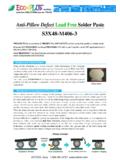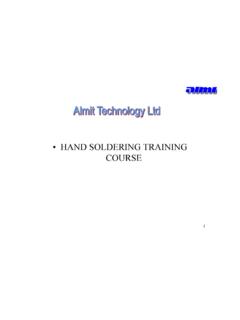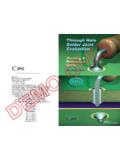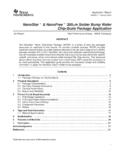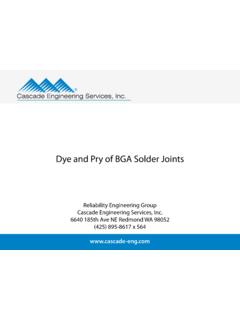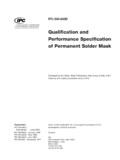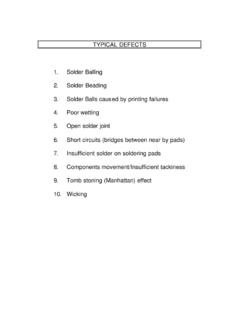Transcription of 'Evaluation of Nickel/Palladium-Finished ICs With Lead ...
1 Application ReportSZZA024 - January 20011 Evaluation of Nickel/Palladium-Finished ICsWith Lead-Free solder AlloysDouglas Romm, Bernhard Lange, and Donald AbbottStandard Linear & LogicABSTRACTA nickel/palladium (Ni/Pd) lead finish for integrated circuits (IC) was introduced in 1989. In1998, solderability test results were published on Ni/Pd-finished components using aSn/Ag/Cu/Sb lead-free (Pb-free) solder paste and printed wiring board (PWB) pads coatedwith organic solderability preservative (OSP). Since then, a number of other Pb-free solderalloys have been evaluation shows soldering and reliability performance of Ni/Pd-finished componentswith the leading Pb-free solder alloys now being considered by the electronics industry. TheICs tested were 20-pin small-outline integrated circuit (SOIC) and 56-pin shrink small-outlinepackage (SSOP) gull-wing leaded devices finished with four-layer Ni/Pd. The solder alloyswere Sn/Pb/Ag (control), Sn/Ag/Cu, Sn/Bi, Sn/Ag/Cu/Sb, Sn/Zn/Bi, and Sn/Zn.
2 The landpads on the test PWB were coated with an OSP. Using Pb-free Ni/Pd-finished components,a Pb-free solder alloy, and an OSP coating, a Pb-free assembly was achieved and , Ni/Pd/Au-finished IC leads were soldered using the Sn/Ag/Cu of each alloy included visual appearance, lead pull before and after1000 temperature cycles, and cross-sections of solder joints before and after of the evaluation indicate good wetting performance of the Ni/Pd-finished ICs, withall of the Pb-free solder alloys tested. In only one case (Sn/Zn/Bi alloy), a slight negativewetting angle was noted at the heel. Lead-pull data shows higher average pull forces for allof the Pb-free alloys versus the Sn/Pb/Ag paste used as a control, with the exception of in a few of the solder joints occurred, but did not impact lead-pull IC leads show good wetting performance with the Sn/Ag/Cu are the property of their respective of Nickel/Palladium-Finished ICs With Lead-Free solder AlloysContentsIntroduction4.
3 Experiment4.. Reflow Profiles5.. Test Equipment and Procedure6.. Performance Measures and Results6.. Visual Appearance7.. Lead-Pull Data8.. Cross Sections of solder Joints9.. Cross-Section Results11.. Intermetallic Results on Cross Sections11.. Ni/Pd/Au Finish14.. Summary of Results15.. Acknowledgment15.. References16.. List of Figures1 Profile for Runs 1, 6, 75.. 2 Profile for Run 25.. 3 Profile for Run 36.. 4 Profile for Run 46.. 5 Profile for Run 56.. 6Sn/Pb/Ag Control Paste, SSOP Package7.. 7Sn/Ag/Cu Paste (235 C Peak), SSOP Package7.. 8Sn/Ag/Cu Paste (260 C Peak), SOIC Package7.. 9Sn/Bi Paste, SSOP Package7.. 10 Sn/Ag/Cu/Sb Paste, SSOP Package8.. 11Sn/Zn/Bi Paste, SOIC Package8.. 12 Sn/Zn Paste, SOIC Package8.. 13 Lead-Pull Results Prior to Temperature Cycling9.. 14 Lead-Pull Results After Temperature Cycling9.. 15 Sn/Pb/Ag solder , 1000 Temperature Cycles9.. 16 Sn/Ag/Cu solder (235 C Peak), 1000 Temperature Cycles9.
4 17 Sn/Ag/Cu solder (260 C Peak), 1000 Temperature Cycles10.. 18 Sn/Bi solder , 1000 Temperature Cycles10.. 19 Sn/Ag/Cu/Sb solder , 1000 Temperature Cycles10.. 20 Sn/Zn/Bi solder , 1000 Temperature Cycles10.. 21 Sn/Zn solder , 1000 Temperature Cycles10.. 22 Sn/Pb/Ag solder , 0 Temperature Cycles12.. SZZA0243 Evaluation of Nickel/Palladium-Finished ICs With Lead-Free solder Alloys23 Sn/Pb/Ag solder , 1000 Temperature Cycles12.. 24 Sn/Ag/Cu solder (235 C Peak), 0 Temperature Cycles12.. 25 Sn/Ag/Cu solder (235 C Peak), 1000 Temperature Cycles12.. 26 Sn/Ag/Cu solder (260 C Peak), 0 Temperature Cycles12.. 27 Sn/Ag/Cu solder (260 C Peak), 1000 Temperature Cycles12.. 28 Sn/Bi solder , 0 Temperature Cycles13.. 29 Sn/Bi solder , 1000 Temperature Cycles13.. 30 Sn/Ag/Cu/Sb solder , 0 Temperature Cycles13.. 31 Sn/Ag/Cu/Sb solder , 1000 Temperature Cycles13.. 32 Sn/Zn/Bi solder , 0 Temperature Cycles13.. 33 Sn/Zn/Bi solder , 1000 Temperature Cycles13.
5 34 Sn/Zn solder , 0 Temperature Cycles14.. 35 Sn/Zn solder , 1000 Temperature Cycles14.. 36 Sn/Ag/Cu Alloy Paste (235 C Peak), Ni/Pd/Au-Finished SOIC Package14.. 37 Sn/Ag/Cu Alloy Paste (260 C Peak), Ni/Pd/Au-Finished SOIC Package14.. SZZA0244 Evaluation of Nickel/Palladium-Finished ICs With Lead-Free solder AlloysIntroductionAn Ni/Pd finish for ICs was first introduced in the late ,2 As of September 2000, morethan 35 billion Ni/Pd-finished IC packages are in the the interest in Pb-free processing that developed during the mid-1990s, the need forPb-free package terminations was ,4,5,6,7,8,9 Because Ni/Pd is a Pb-free finish, use ofNi/Pd-finished components with a Pb-free solder alloy and PWB pad finish can yield a lead-freesolder joint. A study was performed10 in 1998 to evaluate a Pb-free solder joint formed by usingfour-layer Ni/Pd-finished IC components (as well as Ni/Pd/Au-finished components and Sn/Pbplated components as a control), Sn/Ag/Cu/Sb Pb-free solder paste, and an organic solderabilitypreservative (OSP) as the PWB surface finish.
6 Contact-angle measurements and lead-pulltesting were done. Temperature cycling was performed to evaluate the package integrity. Thewetting-balance test was used to determine the solder wetting-times characteristic of the Ni/Pdand Ni/Pd/Au study showed that contact angles increased with Ni/Pd and Ni/Pd/Au finishes. However,Ni/Pd and Ni/Pd/Au finishes achieved equivalent or better lead-pull and temperature-cycleresults versus Sn/Pb-plated component leads (control). This indicated that any difference inperformance of the different lead finishes (Sn/Pb, Ni/Pd, Ni/Pd/Au) was merely visual. By usingeither Ni/Pd- or Ni/Pd/Au-finished IC components, Sn/Ag/Cu/Sb Pb-free solder paste and theOSP PWB surface finish, it was possible to achieve a Pb-free solder European legislation and existing Japanese legislation11,12,13 intensified interest inPb-free processing in late 1999 and into 2000. This interest in Pb-free processing sparked thisevaluation of Ni/Pd-finished components with the industry-preferred Pb-free solder solder alloys chosen for this evaluation were based upon input from customers, industryconsortia, and standards organizations.
7 These are shown in Table 1. solder Alloys Included in This EvaluationRUNALLOYMELTINGPOINT( C)PEAKTEMPERATURE( C)162Sn/36 217240689Sn/8Zn/3Bi187 197225791Sn/9Zn199225 SZZA0245 Evaluation of Nickel/Palladium-Finished ICs With Lead-Free solder AlloysSn/Pb/Ag solder alloy was the control paste. The Sn/Ag/Cu alloy was chosen because this alloyhas been recommended by the National Electronics Manufacturing Initiative (NEMI) as astandardized Pb-free solder The Sn/Ag/Cu class of alloys also has beenrecommended or suggested by IPC, ITRI, and ,16,17 The Sn/Bi alloy was chosen,based on interest by some end users, to develop a process utilizing a lower-temperature meltingalloy. The Sn/Ag/Cu/Sb (Castint) has been available since 1993. This is the alloy evaluated in199810 and is included here for direct comparison to the other alloys. The Sn/Zn/Bi and Sn/Znalloys are being evaluated by the Japanese market, and this warranted their inclusion in the Sn/Ag/Cu alloy, two peak reflow temperatures were used.
8 NEMI has indicated that useof the recommended alloys will raise the melting point by as much as 40 degrees, whichobviously has an impact on a number of the materials and steps in the assembly process, andaffects companies throughout the supply chain. 14 The peak reflow temperature of 260 C hasbeen mentioned as worst case across the industry for the Sn/Ag/Cu alloy. The run using a peakreflow temperature of 235 C was to characterize performance of the Sn/Ag/Cu alloy at a lowerpeak reflow temperature. Skidmore reported that best results were obtained using a linear profileat 235 C peak when evaluating the factors of solder alloy, flux chemistry, and evaluate Pb-free solder joints, an OSP, ENTEK PLUS CU-106A, was used to coat the PWBpad. This coating is a substituted benzimidazole that preserves the solderability of Cu throughmultiple soldering operations. During reflow, most of the OSP is displaced by the wetted solderand becomes a negligible constituent of the solder -paste residue.
9 Some of the OSP (<25%)volatilizes at reflow ProfilesReflow profiles used were based on inputs from the solder -paste vendors. For runs 1, 6, and 7(Sn/Pb/Ag, Sn/Zn, Sn/Zn/Bi alloys), the profile shown in Figure 1 was used. This profile has apreheat range of 140 C to 180 C for approximately 100 seconds, before rising to a peak of225 run 2 (Sn/Ag/Cu alloy), the profile is shown in Figure 2. This profile has a preheat range of140 C to 180 C for approximately 100 seconds, before rising to a peak of 235 1. Profile for Runs 1, 6, 7 Figure 2. Profile for Run 2 SZZA0246 Evaluation of Nickel/Palladium-Finished ICs With Lead-Free solder AlloysFor run 3 (Sn/Ag/Cu alloy), the profile is shown in Figure 3. This profile has a preheat range of140 C to 200 C for approximately 100 seconds, before rising to a peak of 260 run 4 (Sn/Bi alloy), the profile is shown in Figure 4. This profile has a preheat range of100 C to 130 C for approximately 100 seconds, before rising to a peak of 170 3.
10 Profile for Run 3 Figure 4. Profile for Run 4 For run 5 (Sn/Ag/Cu/Sb alloy), the profile is shown in Figure 5. This profile has a preheat rangeof 140 C to 180 C for approximately 100 seconds, before rising to a peak of 240 5. Profile for Run 5 Test Equipment and ProcedureThe solder -paste stencil was a 150-mm stainless-steel stencil, laser cut and polished. Solderpaste printing was done manually. An optical alignment tool for manual component placementwas used to position the device leads to the solder paste prints. Optical inspection of the printedsolder paste on the board was done to ensure adequate paste height and complete printing. Forreflow, a Rehm full-convection oven was used with N2 and O2, 500 ppm to1000 Measures and ResultsWe used visual, mechanical, and reliability-test methods to judge the performance of the solderjoints. Methods used and results obtained are discussed in the following Evaluation of Nickel/Palladium-Finished ICs With Lead-Free solder AlloysVisual AppearanceSolder-joint appearance was used to assess the wetting performance of each paste alloy withthe Ni/Pd-finished components.










